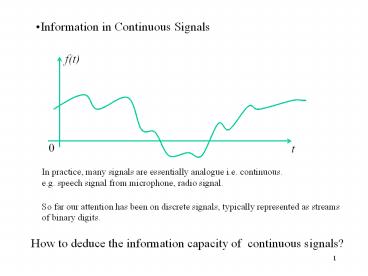Information in Continuous Signals - PowerPoint PPT Presentation
1 / 10
Title:
Information in Continuous Signals
Description:
In practice, many signals are essentially ... The channel capacity C is. C=W log2 (1 S/N) W is the bandwidth 3300-300=3000 Hz. S/N is the signal to ... – PowerPoint PPT presentation
Number of Views:11
Avg rating:3.0/5.0
Title: Information in Continuous Signals
1
- Information in Continuous Signals
f(t)
0
t
In practice, many signals are essentially
analogue i.e. continuous. e.g. speech signal from
microphone, radio signal.
So far our attention has been on discrete
signals, typically represented as streams of
binary digits.
How to deduce the information capacity of
continuous signals?
2
- Sampling Theorem
Numbers of samples/s 2W (1/T 2W ), W ?
Nyquist rate
f(t)
fs(t)
T
t
f
t
2T 3T 4T
F(f)
F (fs)
f
f
-W
W
Spectrum of continuous signal
Spectrum of sampled signal
3
- Information capacity in continuous signal
Information per second R(number of independent
samples/s) (maximum information per sample)
number of independent samples/s 2W
maximum information per sample in discrete
signal? H-Sp log p
What is maximum information per sample in
continuous signal?
number of distinguishable levels S/N
For continuous signal, maximum information per
second is usually denoted as Information
Capacity
C2Wlog(S/N)W log (SNR)
4
- Relative Entropy of Continuous Signal
Discrete systems
Continuous systems
Gaussian
5
- Information Capacity of Continuous Signals
Input (x)
Output (y)
Channel
Power (S)
Power (SN)
Information Capacity CH(y)-H(n)2W
This leads to Ideal Communication Theorem ?
CWlog(1S/N)
Theoretically information could be transmitted at
a rate up to C with no net errors.
6
Transmission Media
The physical medium of electronic transmission
limits its achievable bit rate. It acts as a
filter on the signal being transmitted.
7
(No Transcript)
8
Shannons Theorem
Our phone line can carry frequencies between 300
Hz and 3300Hz unattenuated. The channel capacity
C is CW log2
(1S/N) W is the bandwidth 3300-3003000 Hz. S/N
is the signal to noise ratio, typically 1000,
which corresponds to 10 log10 (S/N) dB 30dB.
In our case C30 kbs, corresponds well with a
28.8kbs modem.
9
- Implications of the Ideal Theorem
IWTlog(1SNR) bits in time T.
A given amount of information can be transmitted
by many combinations of W, T, SNR
W
3
C3 units T1s
2
c
a
1
b
60
SNR
10
a. W1, SNR7, b. Half W ? S/N 63. Requires
very large increase in power. c. Half S/N ?
W?1.5. Useful can halve power with only 50
increase in bandwidth.
10
- Maximum Capacity for given transmitted Power
CW log (1S/N) ?S/N0 nats 1.44S/N0 bits
(about 310 ? ²¹ W required to transmit 1 bit.)
CWlog(1S/(N0 W)) , where N0 is noise power
spectral density.
Max value of C occurs for W? 8, and P/N ?0
This suggests that power should be spread over a
wide bandwidth and transmitted at as low P/N as
possible for efficiency in power requirements.































